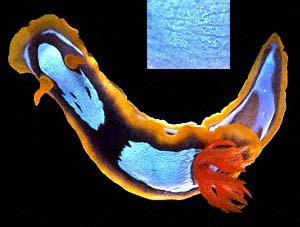
Chromodoris westraliensis
(O'Donoghue, 1924)
Order: NUDIBRANCHIA
Suborder: DORIDINA
Family: Chromodorididae
DISTRIBUTION
Western Australia
PHOTO
UPPER: Rottnest Island, Perth, Western Australia. 65mm long alive. Inset showing punctate nature of blue region. PHOTO: Bill Rudman.
LOWER LEFT: Transits Reef, Rottnest Island, Western Australia, November 1983.
PHOTO: G. Saueracker.
LOWER RIGHT: Cervantes Island, Western Australia. Showing colour variation.
PHOTO: Clay Bryce.
Chromodoris westraliensis is apparently endemic to Western Australia. The top photo shows the "typical" colour form described by O'Donoghue. In this the black forms a band which is against the inside edge of the orange marginal band. There is also a solid black patch breaking the blue patch into an anterior and posterior section. The gills and rhinophores are distinctly deeper - almost red - in colour than the orange border. However the other photos show that the black line can be separated from the orange border by a white or bluish gap and the black median patch can be absent. In most specimens the blue region is punctate (ie: with fine darker specks), very similar to Chromodoris annae. perhaps this species has evolved in Western Australia from that species? At present there are a number of similarly coloured species occurring on the Western Australian coast which will only be sorted out by further collecting.
Reference:
•Rudman, W.B. (1982c) The Chromodorididae (Opisthobranchia: Mollusca) of the Indo-West Pacific: Chromodoris quadricolor, C. lineolata and Hypselodoris nigrolineata colour groups. Zoological Journal of the Linnean Society 76: 183-241.
LOWER LEFT: Transits Reef, Rottnest Island, Western Australia, November 1983. PHOTO: G. Saueracker.
LOWER RIGHT: Cervantes Island, Western Australia. Showing colour variation. PHOTO: Clay Bryce.
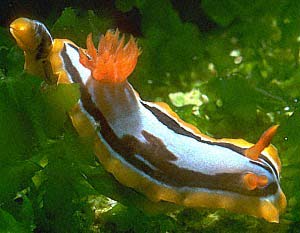
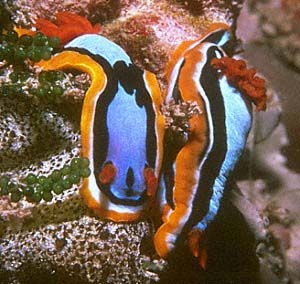
Rudman, W.B., 1998 (November 19) Chromodoris westraliensis (O'Donoghue, 1924). [In] Sea Slug Forum. Australian Museum, Sydney. Available from http://www.seaslugforum.net/find/chrowest
Related messages
Chromodoris westraliensis from Exmouth, Western Australia
April 4, 2008
From: Bruce Potter
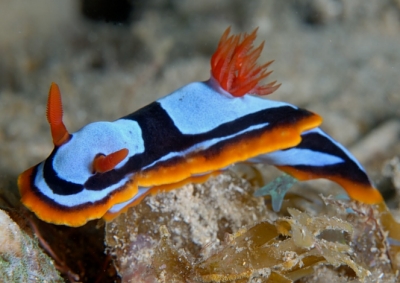
Dear Bill,
This is the 5th of the blue black and orange chromodorids from the Exmouth Navy Pier. [see also messages 20980, #20981, #20982,#20983 ].
This one I am sure is Chromodoris westraliensis
Locality: Exmouth, 10 - 12 metres, Western Australia, Indian Ocean, 5 October 2007, under a jetty. Length: 35 mm. Photographer: Bruce Potter.
Regards
Bruce Potter
bandppotter@bigpond.com
Potter, B., 2008 (Apr 4) Chromodoris westraliensis from Exmouth, Western Australia. [Message in] Sea Slug Forum. Australian Museum, Sydney. Available from http://www.seaslugforum.net/find/20984Dear Bruce,
This is a 'classical' version of C. westraliensis - at least one of your 'species' is easy to identify.
Best wishes,
Bill Rudman
Chromodoris annae or C. westraliensis? from Exmouth
April 4, 2008
From: Bruce Potter
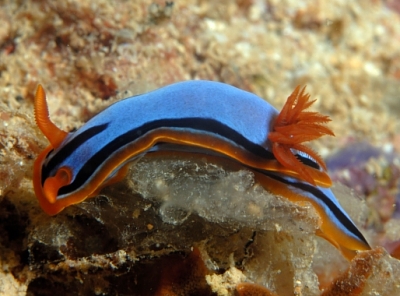
Dear Bill,
Here is number 3 of the blue black and orange Chromodorids from the Exmouth Navy Pier.
Locality: Exmouth, 10 - 12 metres, Western Australia, Indian Ocean, 5 October 2007, under a jetty. Length: 35-40 mm. Photographer: Bruce Potter.
I think it may be Chromodoris annae . [see also 20980, #20981, #20983,#20984].
Regards
Bruce Potter.
bandppotter@bigpond.com
Potter, B., 2008 (Apr 4) Chromodoris annae or C. westraliensis? from Exmouth. [Message in] Sea Slug Forum. Australian Museum, Sydney. Available from http://www.seaslugforum.net/find/20982Dear Bruce,
This certainly has the general look of C. annae, but in that species the orange border is submarginal, while the actual mantle edge is white. There is also a white band inside the orange band as well. In your animal the orange border reaches right to the edge and there is a blue band inside separating the outer orange and inner black lines. In this case your animal is C. westraliensis. This specimen is unusual because it lacks the black patch in the middle of the mantle.
Best wishes,
Bill Rudman
Chromodoris westraliensis from Ningaloo
January 5, 2005
From: Kristin Anderson
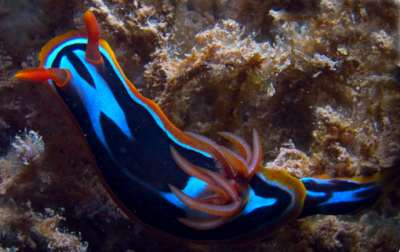
Not sure if these are simply more colour variations of Chromodoris elisabethina or if they are different species altogether. We seem to get quite a variety of these orange, blue, black, white nudibranchs and some of the colour variations are tricky for us!
Locality: Ningaloo Reef, Exmouth Gulf, Western Australia, Indian Ocean. Depth: 10 m, Length: 30-40 mm. 30 December 2004, silty bottom
Photographer: Kristin Anderson
Kristin Anderson
kristin@exmouthdiving.com.au
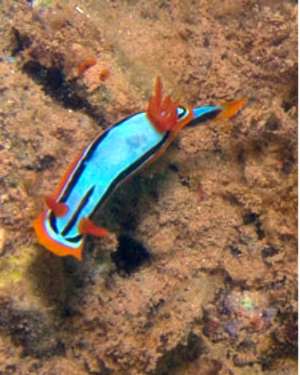
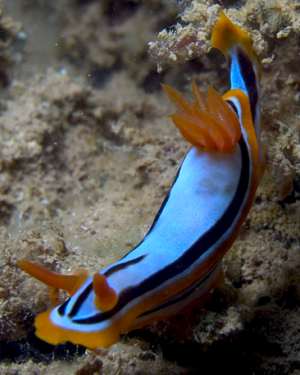
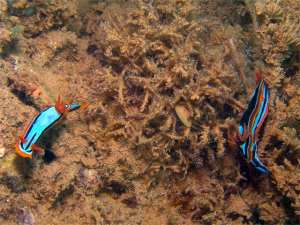
Dear Kristin,
These are both Chromodoris westraliensis, which as the name suggests, are found in Western Australia. It shows quite a bit of colour variation, and looks quite like two other species, C. elisabethina and C. annae. If you look at some other photos on the Forum you will see that both C. westraliensis and C. annae have small dark spots on the blue region of the mantle [we call this a punctate pattern] which suggests that perhaps the two species are closely related. The main differences are that in C. westraliensis there is usually a black band across the central part of the mantle, and there is usually a trace of black between the orange mantle border and the blue inner colouration. You can see that in the upper right and bottom left photos.
And before you say it - I can't see the punctate pattern in your photos. Perhaps the lighting disguises the dark specks in your photos?
Best wishes,
Bill Rudman
Chromodoris westraliensis from W. Australia
February 11, 2004
From: Monika Stambergova
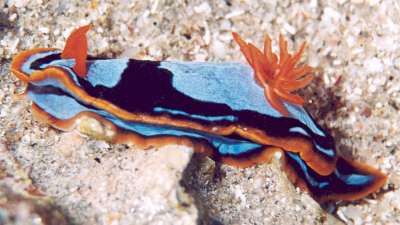
Dear Dr. Rudman,
I wish to ask you about some species I and my friend found in Western Australia last year. I took pictures of them, which I enclose. I wonder, if this one is Chromodoris westraliensis?
1 September 2003, Kalbarri Nat.Park, Kalbarri, rocky sea-coast, found in water pools at low-tide.
With best wishes
Monika Stambergova
Czech Republic
stambergova@nature.cz
Stambergova, M., 2004 (Feb 11) Chromodoris westraliensis from W. Australia. [Message in] Sea Slug Forum. Australian Museum, Sydney. Available from http://www.seaslugforum.net/find/12121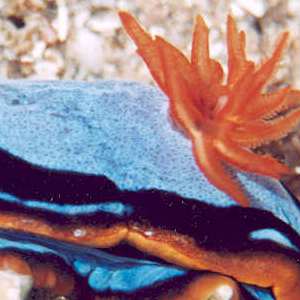
Dear Monika,
This one is indeed Chromodoris westraliensis, a most appropriate species to find in Western Australia. The colour pattern in very characteristic, and as you can see in the close-up alongside, the blue is patterned with dark spots.
Best wishes
Bill Rudman
Chromodoris westraliensis from the north of WA
April 28, 1999
From: Clay Bryce
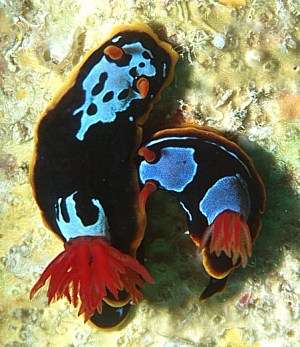
Bill,
Here is a very northern record of Chromodoris westraliensis from Cassini Island in the Kimberley region of northwestern Western Australia. It is common on Cassini I and occurs to Long Reef further north.
Clay Bryce
Western Australian Museum
Perth.
brycec@museum.wa.gov.au
Bryce, C., 1999 (Apr 28) Chromodoris westraliensis from the north of WA. [Message in] Sea Slug Forum. Australian Museum, Sydney. Available from http://www.seaslugforum.net/find/809Thanks Clay,
We're building up quite a picture of the colour variation in the species,
Bill Rudman.
